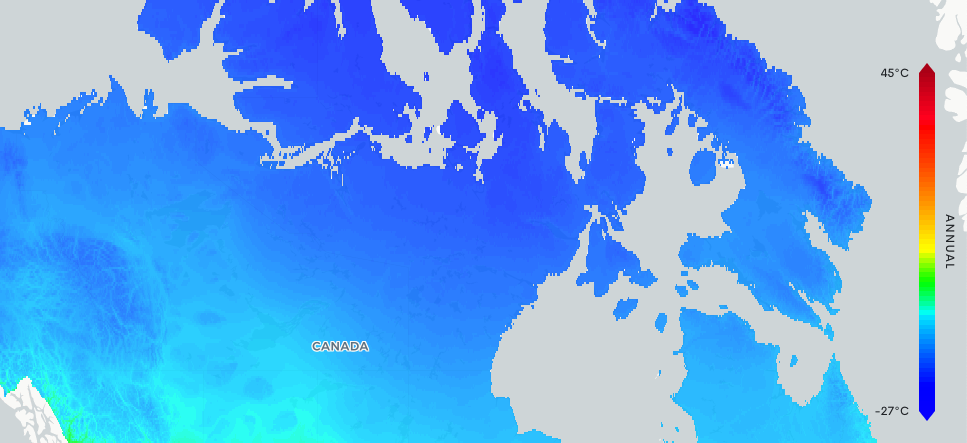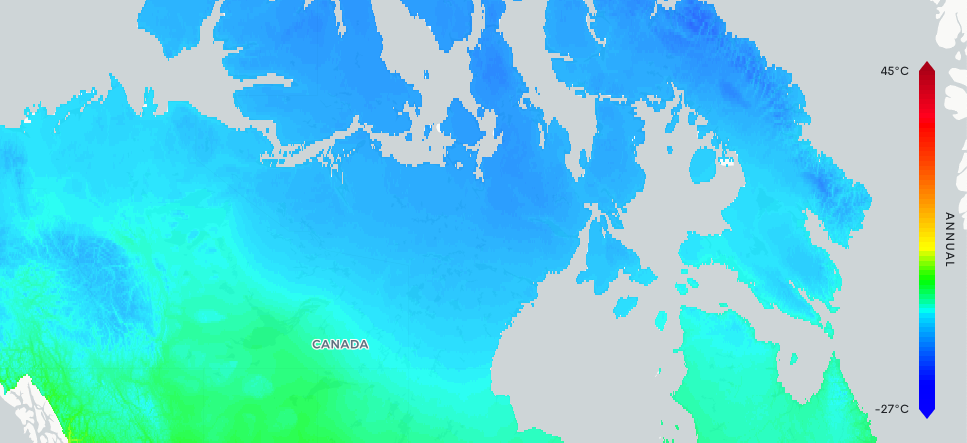While increasing temperatures are important, this was only the first step of the analysis, since permafrost also responds to ground moisture. Wet and warm conditions, occurring together, can accelerate the thermal breakdown of permafrost. To examine this effect, the WSP consultants seized on work by permafrost scientist Steve Kokelj of the Northwest Territories Geological Survey, which indicated that permafrost slump could occur when daily rainfall exceeded 40 mm.
To apply this rainfall threshold up to the current time horizon, WSP used historical rainfall intensity-duration-frequency (IDF) curves produced by Environment and Climate Change Canada (ECCC). These datasets describe the historical frequency of extreme rainfall of short duration (from five minutes up to 24 hours) at a particular location. IDF curves are used by engineers and water resource managers for flood forecasting and urban drainage design. Historical IDF data are readily available via ClimateData.ca.
The challenge with using IDF curves for this application though, stress the WSP consultants, is that they are based on rate-of-rainfall data in the past, and cannot on their own be used to estimate extreme rainfall in a changing climate. Moreover, IDF curves are available only at selected locations across Canada. WSP therefore made use of the IDF_CC Tool developed at Western University to estimate the probability of future rain events surpassing the 40 mm threshold. This tool provides IDF curve projections across the whole Canadian territory. “There are limitations associated with the use of this climate change data at such a significant spatial scale, so the Tool outputs should be paired with a sensitivity analysis specific to the area of the project, before being relied upon for design purposes,” Paré adds. Despite these limitations, however, they are a good starting point. “This is what we had to use for projecting sub-hourly extreme storm events, which are used in building design criteria,” explains her colleague, Jean-Phillipe Martin.
Ultimately, the consultants concluded that while increasing temperature is the primary driver of permafrost thaw, increasing precipitation and precipitation extremes could accelerate degradation, particularly where heat is transmitted to ice-rich permafrost via rain, causing thawing through a process called thermo-erosion. It was further concluded that greater permafrost thaw hazard is due to a higher incidence of ice-rich permafrost and fine-grained sediments. Thawing of ice-rich permafrost can cause abrupt and dramatic changes to the landscape, such as slumping, sinkholes, landslides, and the sudden expansion or drainage of water bodies.
“Engineers tend to want a specific number, such as those provided in standards and codes, where the risk of uncertainty has been managed collectively by others,” she explains. “When integrating climate projections into design criteria, a risk management approach should be taken,” she adds. The changing climate has necessitated working with degrees of uncertainty and ranges of data rather than with precise data that are assumed to be certain. In this respect, changes in the approach and language of experts are necessary. The products developed by ClimateData.ca can help to hasten this evolution.
“You should not just have just one number. You should actually be thinking: ‘What are the consequences of failure? How badly will it go if I get it wrong?’ This is way more important than being able to say whether it will be a 20% or 22% increase.” This kind of thinking, Paré concludes, is how we can start to embrace a risk-based approach to designing buildings in the rapidly changing north.






